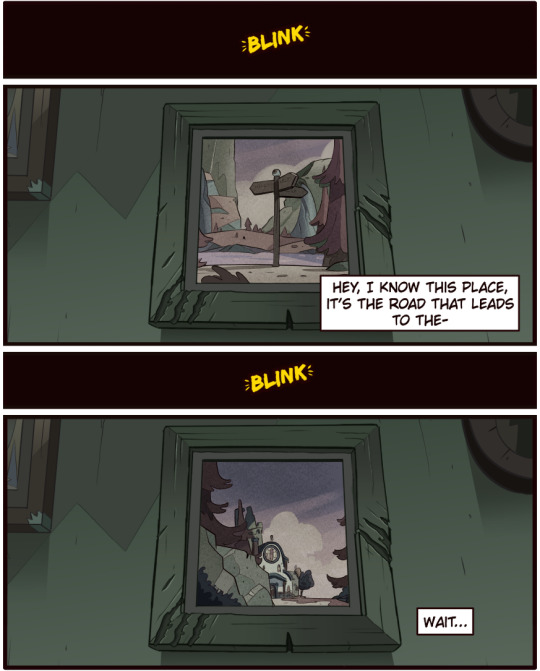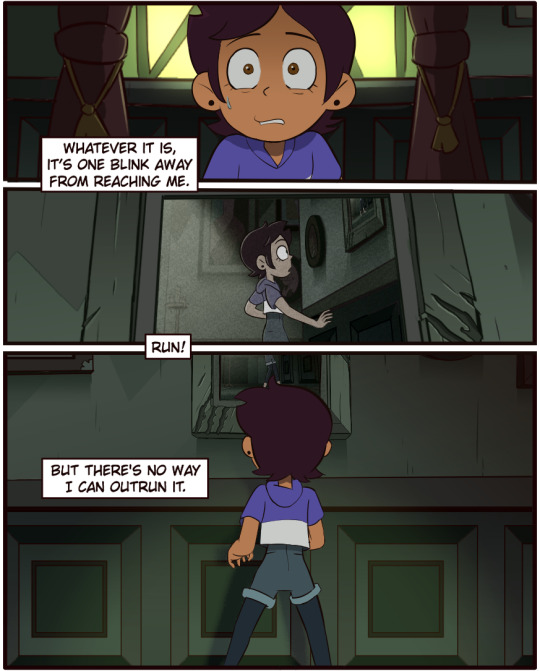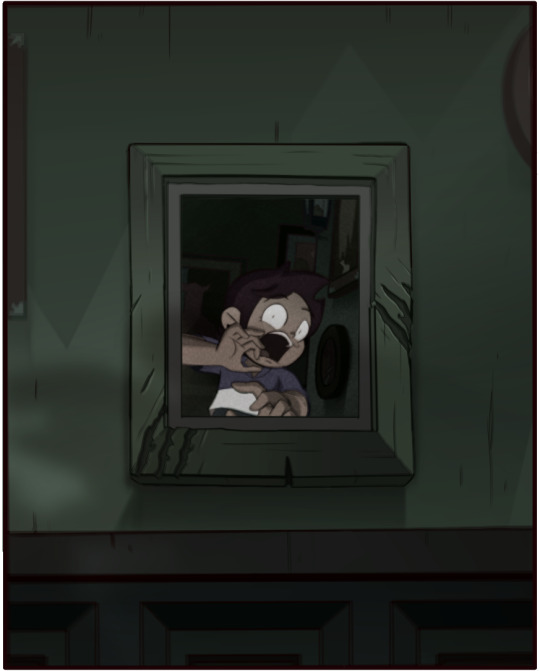Text
Soulslike NPC where after you complete their questline they’re gone from their usual spot and you find their blood-spattered armour lying empty beside a river, but if you loot it you run into them again later in some incongruous location, alive and well and complaining about how they were taking a bath because they’d gotten blood all over themselves and someone stole their pants.
14K notes
·
View notes
Text
When you learned of the god of war, you thought he’d be tall and muscular and angry. When you were about to meet him, you braced yourself for the worst.
You weren’t quite expecting the short, scrawny, shy kid you ended up getting instead.
105K notes
·
View notes
Text
The haunted inn
Walk into a tavern, ask for room, all rooms are booked.
Well
Almost all the rooms
There is one left, but the owner doesnt usually rent it because its room number 13 and people think its haunted. But hey its fine you need a room and this guy can get over a little superstision.
The keep walk you up to the first floor, down to room 13, and with a satisfying clock the door opens. It's dark inside, but a flash of lightning from out side reveals the typical beds along with a desk and a lamp or wall sconce of some kind.
The thunder subsides.
"Let me get the light for you"
The keep collects himself and walks into the room, striking a match and lighting a lamp inside the room.
"See? Nothing to worry about."
First the lamp and match flicker and extinguish in turn. The room and the owner are cast in darkness.
Then, with a mother much closer crack of lightning the keeps figure is illuminated, long spindly black finger clasping his neck, his face now bearing a swallowed expression of relief now absent of life. The door slams fully opened with the thunderous weather as darkness seeps into the hallway where you stand.
Roll for initiative.
0 notes
Text
https://vm.tiktok.com/TTPdhLJoHK/
0 notes
Photo
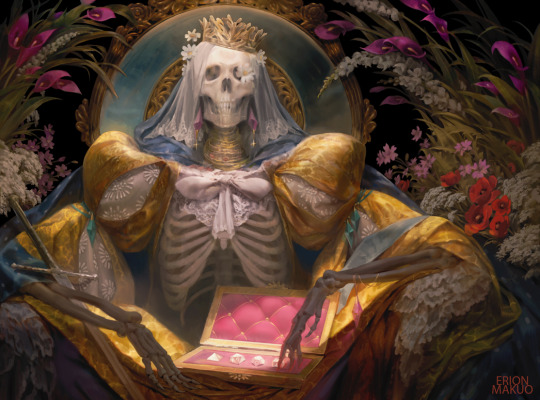
Summer King, a packaging illustration done for EVERYTHING DICE
6K notes
·
View notes
Photo
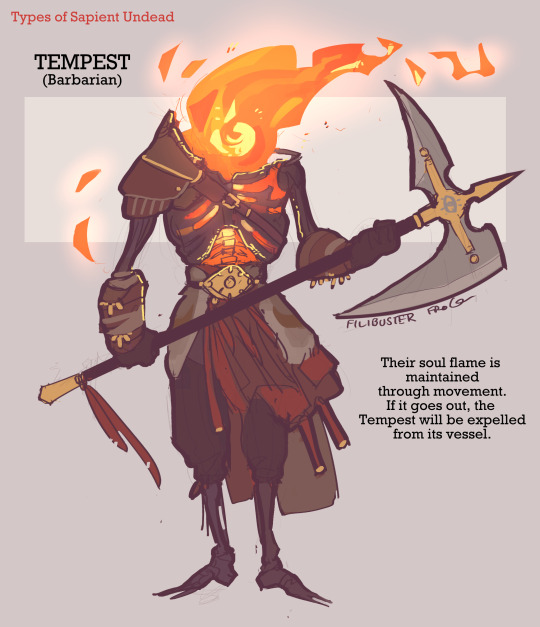
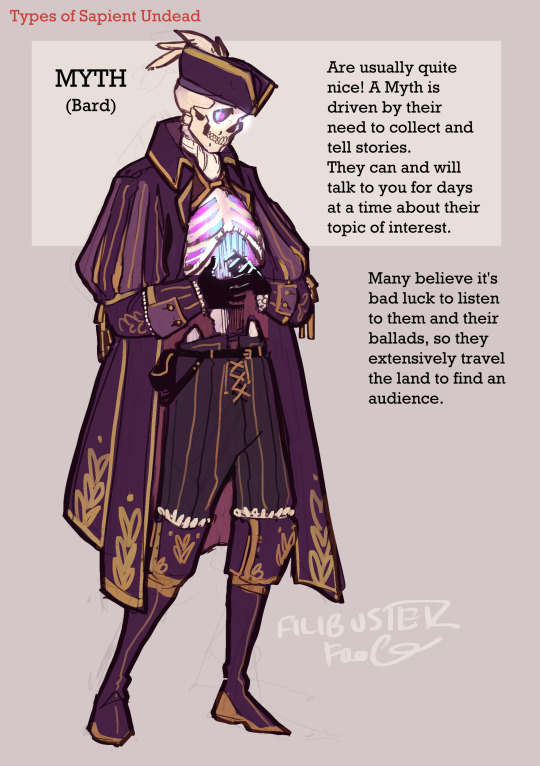


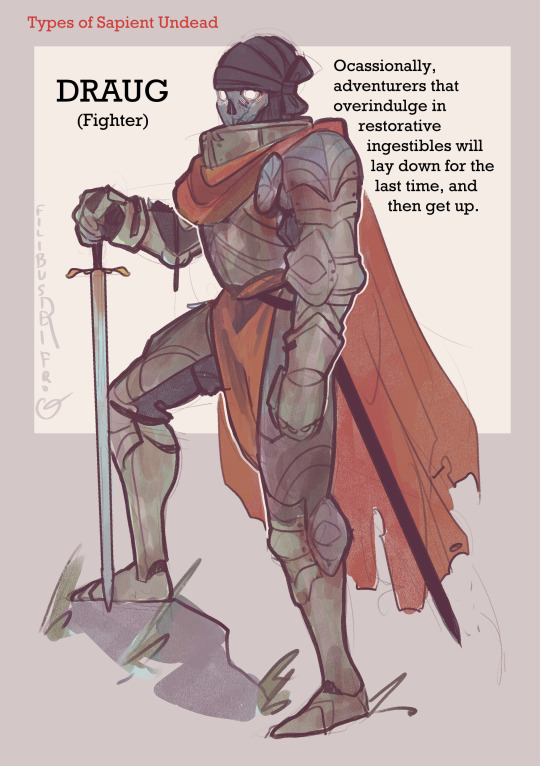



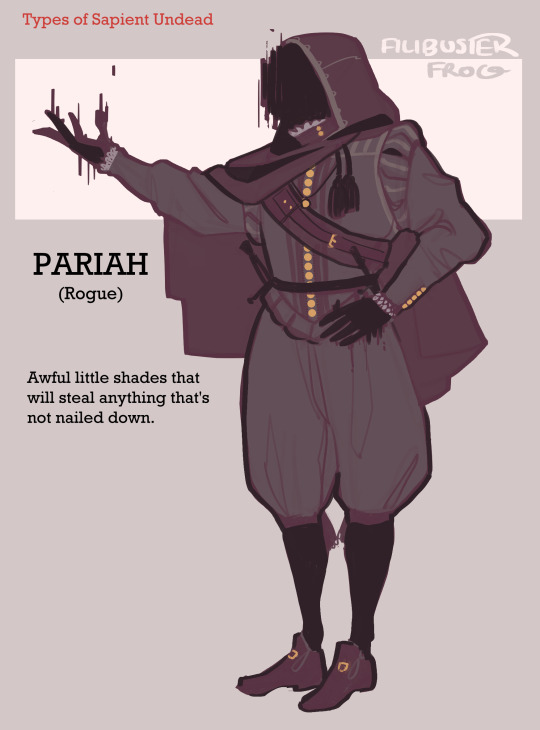
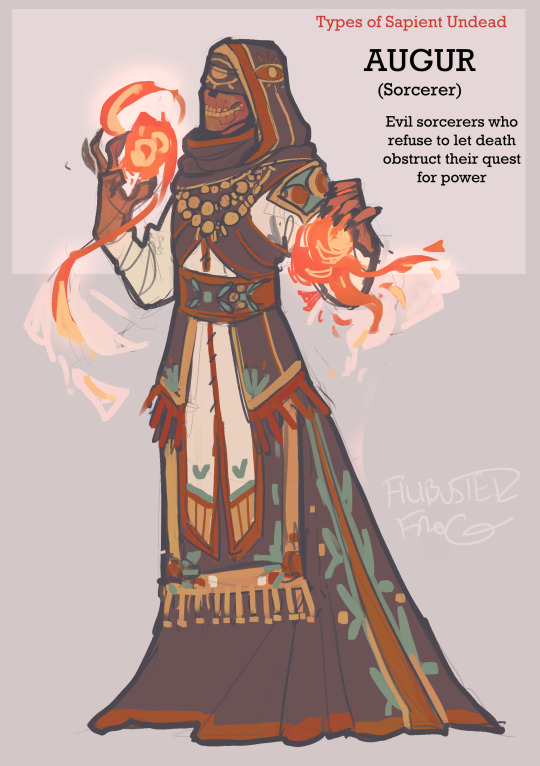
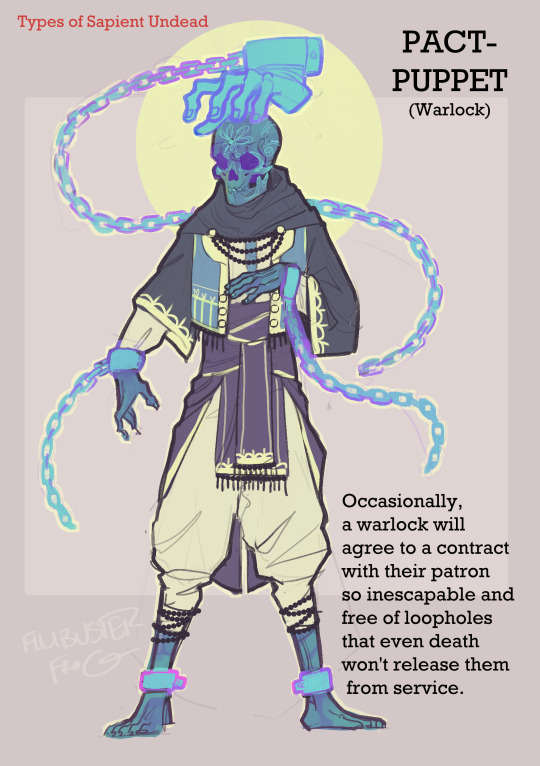
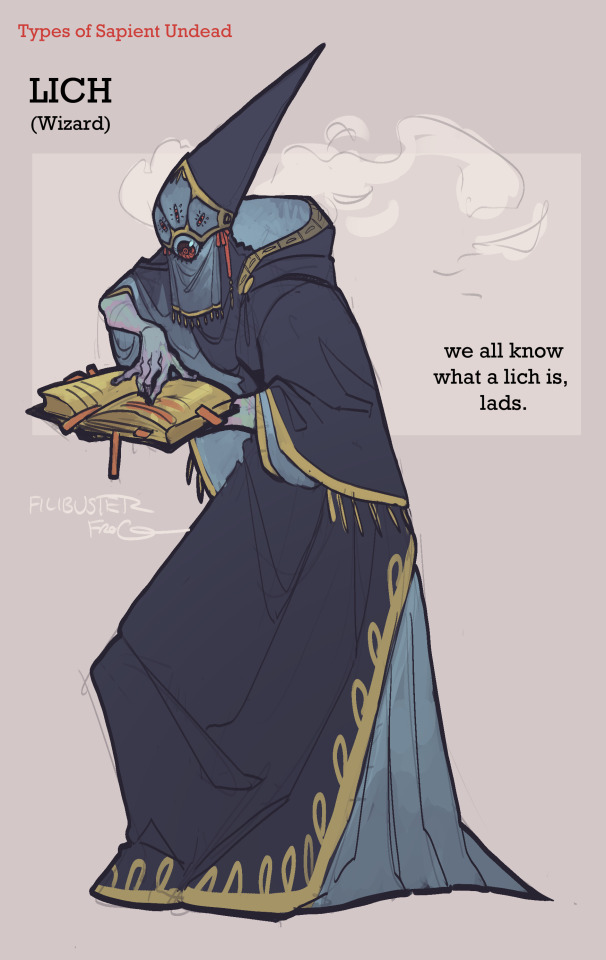
core classes as undead :)
130K notes
·
View notes
Text
My roommate introduced me to a D&D podcast called Dungeons and Daddies about a group of dorky suburban dads who get transported, along with their kids, to D&D land. Anyway it’s fun, hilarious, the story is well done, etc.
But something they do at the start of every episode is something called Dad Facts. Each player lists off a dad fact about their character, something about their interests or history or personality, that the other characters would have known but “off camera” rather than having all these details RP’d out. After all, your characters in games spend a LOT of downtime together in between scenes, this sort of stuff WOULD have come up.
So, now, just about EVERY RP game I’m in has incorporated Dad Facts, including ones where I and my roommate are the only ones who’ve heard the damn podcast. Some players don’t even know why we CALL them “dad facts”, but they still run with it.
Anyway I recommend it to every RP group. NOT right away, if your characters have JUST met, because some of this shit just flat out won’t be known until after you’ve already had that downtime together.
Some of mine are big and revealing, some are as simple as “Zenrae doesn’t like eating fish” or “Theria only drinks sweet wine and otherwise finds alcohol offputting” - little moments and traits and stuff you want to get out there but haven’t been able to. It helps you flesh your own character out, helps you get to know the other characters better, and helps RP along SO. MUCH. I have used others’ dad facts to help RP in game and I can’t stress enough how fun that is
And I swear in my groups I tried, like, two whole times to coin a term OTHER than “dad facts” but nope. Dad Facts is sticking.
Anyway that’s my ramble for the day
6K notes
·
View notes
Text
combat additions to make it actually take more than a round for your players to kill your cool boss
difficult terrain. flood that cavern! oops the floor is lava! make the walls attack and grapple!
environmental effects in general. make an avalanche happen as soon as combat starts. combat during a storm is a great opportunity for lightning to strike. rain, snow, darkness, distance, fog, anything that’ll impose disadvantage on their hits.
charm and fear effects. charm/fear conditions on a PC or two can totally turn the tide of an encounter.
straight up just swallow somebody. sometimes ingestion is the answer.
official statblock be damned, your boss should ALWAYS have additional legendary actions and/or resistances, condition and damage resistances/immunities, multiple attacks (probably more than the statblock says) and a motherfucking escape plan!
portals. seriously, just chuck some portals in there. I’ve never run a combat that couldn’t be improved by the addition of a portal or two.
time constraints, mid-combat puzzles, a non-combat goal, anything the PCs have to do during the fight that isn’t actually fighting.
in general, just get weird with it! wizards of the coast doesn’t own you! no gods no masters! hit harder and have more fun!
5K notes
·
View notes
Photo

Fantasy binder.
49K notes
·
View notes
Text
Here’s a little trick I’ve used in D&D games where the premise of your campaign calls for the party to have access to lots of Stuff, but you don’t want to do a whole bunch of bookkeeping: the Wagon.
In a nutshell, the party has a horse-drawn wagon that they use to get around between – and often during – adventures. This doesn’t come out of any individual player character’s starting budget; it’s just provided as part of the campaign premise.
Before setting out from a town or other place of rest, the party has to decide how many gold pieces they want to spend on supplies. These funds aren’t spent on anything in particular, and form a running total that represents how much Stuff is in the wagon.
Any time a player character needs something in the way of supplies during a journey or adventure, one of two things can happen:
1. If it’s something that any fool would have packed for the trip and it’s something that could reasonably have been obtained at one of the party’s recent stopovers (e.g., rations, spare clothing, fifty feet of rope, etc.), then the wagon contains as much of it as they reasonably need. Just deduct the Player’s Handbook list price for the item(s) in question from the wagon’s total.
2. If it’s something where having packed it would take some explaining, or if it’s something that’s unlikely to have been available for purchase at any of the party’s recent stopovers (e.g., a telescope, a barrel of fine wine, a book of dwarven erotic poetry, etc.), the player in need makes a retroactive Intelligence or Wisdom check, versus a DC set by the GM, to see if they somehow anticipated the need for the item(s) in question. Proficiency may apply to this check, depending on what’s needed. The results are read as follows:
Success: You find what you’re looking for, more or less. If the group is amenable, you can narrate a brief flashback explaining the circumstances of its acquisition. Deduct its list price (or a price set by the GM, if it’s not on the list) from the wagon’s total.
Failure by 5 points or less: You find something sort of close to what you’re looking for. The GM decides exactly what; it won’t ever be useless for the purpose at hand, but depending on her current level of whimsy, it may simply be a lesser version of what you were looking for, or it may be something creatively off the mark. Deduct and optionally flash back as above.
Failure by more than 5 points: You come up empty-handed, and can’t try again for that item or anything closely resembling it until after your next stopover.
As an incidental benefit, all the junk the wagon is carrying acts as a sort of ablative armour. If the wagon or its horses would ever take damage, instead subtract a number of gold pieces from its total equal to the number of hit points of damage it would have suffered. The GM is encouraged to describe what’s been destroyed in lurid detail.
40K notes
·
View notes
Photo

SUPERSTITIONS ON THE HIGH SEAS
TATTOOS & PIERCINGS These are said to ward off evil spirits
SPIT INTO THE OCEAN Before you sail will bring you good luck
TOSS IN A COIN Tossing a coin in the ocean before you depart is said to pay a toll to the god of the ocean. It will bring safe passage.
GOLDEN EARRINGS Were said to give better eyesight and protect from drowning.
RED SKY “Red sky at night, sailor’s delight; red sky in the morning, sailors take warning”
WHISTLING Never whistle on a boat for you will “whistle up a storm”.
RIGHT FOOT FIRST Always step onto a ship with your right foot first. Stepping with your left is sure to bring disaster.
RE-NAMING A BOAT Bad luck will fall on the crew if a boat is renamed without a proper de-naming ceremony.
LOSING YOUR HAT Losing your hat overboard is a sign that the trip will be a long one.
BANANAS Bananas should not be brought onboard a ship or they would cause the ship to be lost
SHARKS A shark following alongside the boat is a sign of inevitable death. Turtles are said to bring good luck so carrying their bones in your pocket can save you from this inevitable death
ALBATROSS These birds are said to be the soul of a dead sailor. Killing one will bring bad fortune to everyone on board. To right this one must tie the body of the bird to the neck of the murderer and tie them to the main mast.
RINGING BELL If a bell were to ring on its own its a sign that someone on board will die.
1K notes
·
View notes
Photo


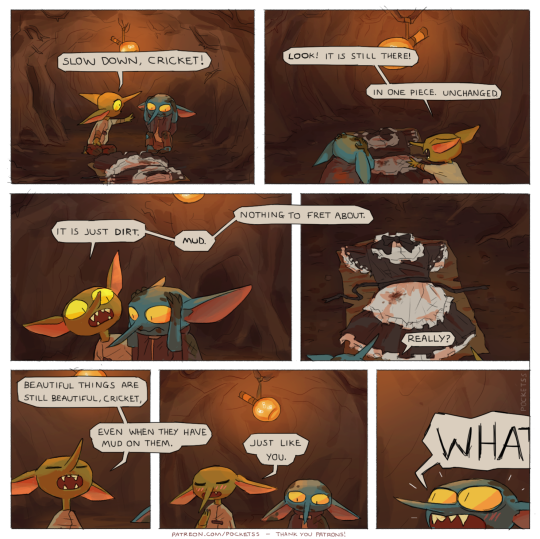
cricket finds compliments very alarming
82K notes
·
View notes
Text
Fairy: Hey I didn’t get your name.
Me: Yeah that was on purpose.
Fairy: Oh my god stealing people’s names has been categorized as a war crime for like a hundred years. Do I seem like the kind of fairy that would do war crimes?
Me: Well yes, but that’s just my impression of you personally. Not fairies in general.
Fairy: You’re smarter than I thought.
108K notes
·
View notes
Text
Fantasy Guide to Ships, Boats and Nautical Lingo
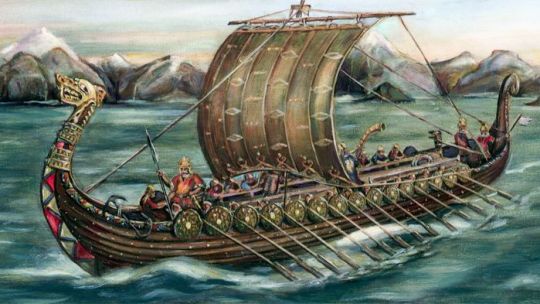
Of all the ways to travel in fantasy and historical novels, there are two favoured ones: horses and ships. But I covered the horses already so here we have some ship terminology and kinds of ships.
Common Boat Terms

Aft/Stern - The back of a ship.
Bow - The bow is the front part of the ship, the pointy part or the place where Kate Winslet stood on in Titanic.
Port - The left side of the ship
Starboard - The right side of the ship
Windward - The wind the direction is blowing.
Hull- outside of the ship
Leeward - Or sometimes called the lee. This is the opposite direction of the wind is blowing
Boom - A horizontal pole extending from the base of the main mast. It adjusted toward the wind direction in order to harness the wind for the sails.
Rudder - The rudder is a flat piece of wood below the ship, used to steer the ship. It is connected to the wheel of the ship.
Tacking - A common sailing maneuver that involves turning the bow through the wind, to change the wind direction from one side of the ship to the other, making the boom move.
Underway- This is when the ship is moving
Astern- The ship is moving backwards
Amidships- Middle of the boat
Topside- when you move from the lower decks to the upper deck
Compartments of the ship
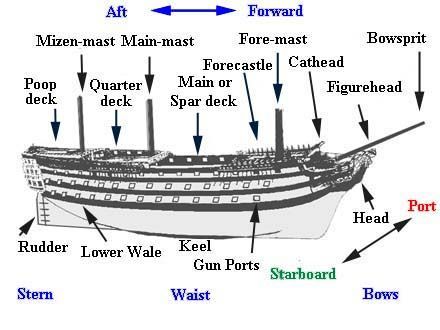

Most ships would have compartments inside the hull and underneath the deck.
Cabins- most war ships and merchant ships would only have one or two main cabin occupied by the captain and higher crew.
Galley- The kitchen on board the ship. The galley would be fitted with tables and cabinets. Galleys were built in such a way that they were more resistant to the heaving of the ship. Most galleys were built with special stoves to stop people from colliding with them and things from spilling out of pots and pans.
Wardroom- some ships are built with a common room for the crew. The wardroom acted as a common room as well as a dining room. It would usually be conjoined with the galley.
Sick Bay- is the compartment of the ship that is given over to the injured and sick. The sick bay would hold the medicines and medical devices and would often be under lock and key.
Hold- This will be the largest compartment in the ship were the cargo or the ship's weapons.
Crew and Positions aboard the Ship

Captain
When we think of captains we imagine them as blackhearted slave drivers (something akin to managers in the customer service industry) but on further research you will find that is not true. There are two kinds of Captains you find in history. Pirate captains and Legitimate Captains. Pirate captains were elected by their merit in battle and dedication to the crew. They were considered equal to the crew, only taking full charge during raids and battles. In the Navy or any legal-bound ship, captains were selected by rank and wealth. There was no equality between captain and crew as in pirate ships. Legal ships were Capitalists and the Pirates were Democratic.
First Mate
First Mate is the captain's deputy. They act as captain when the captain cannot. This was mainly seen in Navies and merchant ships as Pirates usually placed their quartermaster as their deputies.
Quartermaster
The Quartermaster was in charge of ensuring that the ship ran smoothly, rather like the ship's HR manager. The Quartermaster was in charge of supplies and had certain powers such as being able to punish the crew for minor infractions.
Sailing Master
These were officers in charge of piloting the ship. They would have to be educated enough to read a map and was a much desired position because it was a fair paying job. Pirates usually kidnapped sailing masters from ships they attacked to use aboard their own ships.
Gunner
Gunners were the overseers of any many qualified to load and fire guns. They were in charge of aiming cannons and making sure the crew were safely using guns. Most the guns were loaded by young boys called powder monkeys.
Boatswain
Boatswains or junior officers would act as supervisors, watching over the crew as they did their duties. If things were not going well they reported to the captain or quartermaster to punish the crew.
Surgeons
Surgeons handled any diseases and wounds. Since being at sea limited the amount of medicine available. Most ship's surgeons were forced to cut off limbs to avoid infection pike gangrene. Surgeons may not always be found on ships. Cooks or carpenters were often pressed to do amputations: meat was meat and cutting was cutting.
Cooks
All ships needed somebody to cook. Navies and merchant ships would often have trained cooks while on pirate ships it was just a crewmember who was handy in the kitchen.
Kinds of Ship
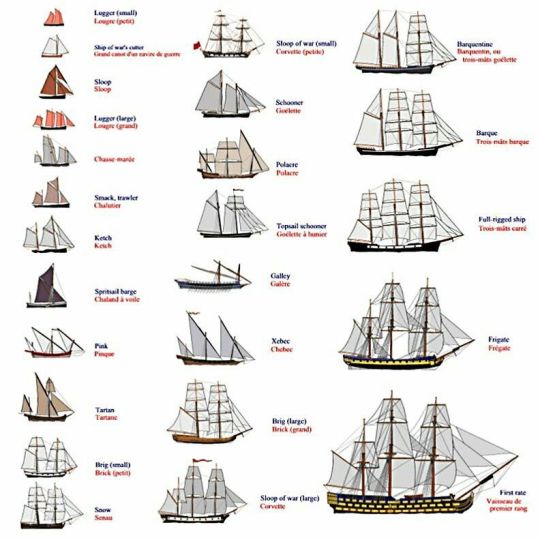
(Not a complete list, may post more later.)
Brig- A brig is the ship that one most thinks of when you think of a ship. The brig is a large vessel, set with a pair of square-rigged masts. Brigs were fast ships and highly maneuverable. They were used as merchant ships and warships.
Galley- The galley is propelled via oars. The hull is long and slender and most of them featured larger sails. Galleys often were rowed by slaves and used in war.
Galleon- Galleons were large ships, built with multiple decks, carrying three or more masts with square raised stern. The Galleon was usually rigged with square sails on the fore-mast and main-masts.
Caravel- The caravel was a small ship with triangular sails, famed for its manoeuvrability and speed.
Longship- The longships were the ships of the Vikings. They were slender ships, narrow. They were able to keep afloat in shallow waters as well as the deep sea. Longships were able to reverse quickly, a very important skill. The longship was a warship, a raider's ship propelled by oars.
Carrack- the carrack was a large ship, often built with mass cargo holds making the most popular ship to go on long voyages on. The carrack had three or four masts.
Cog- This ship was a large vessel, the hull wide and large. The ship is propelled by a great single sail flown from a tall mast.
Junk- The junk or Chinese junk was a kind of coastal or river ship used as merchant ships, pleasure ships and sometimes houseboats. They are small ships and made with battened sails rather resembling wings.
Trireme- the trireme was a slender ship set with three banks of oars pulled by one man each. The trireme had a concave hull and usually had an underwater ram at the prow of the ship.
For @viola-cola
21K notes
·
View notes



